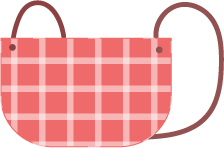PPE Components
1. Gloves1,2
Gloves protect against the transfer of infectious agents to the hands during direct contact with patients or their immediate environments. They protect both the patient and the wearer.
There are 2 main types of gloves that you may be provided or asked to use during your clinical rotations:
- Examination gloves–typically thinner and non-sterile, used for non-invasive procedures
- Surgical gloves–typically thicker and more durable, are sterile
These gloves are made of latex, vinyl, neoprene or nitrile material.2
2. Gowns
Gowns help protect health care providers against infectious agents that can land on skin or clothing. They protect HCP’s clothing and forearms during contact with patients or their immediate environments. They also provide some resistance to water spray.
There are 2 main types of gowns that you may be provided or asked to use during your clinical rotations:
| DISPOSABLE | REUSABLE | |
|---|---|---|
| MATERIAL | Made of polyproplyene | Made of textile/cloth |
| USAGE | Not amenable to reuse as ties and fasteners typically break during removal | Can be safely laundered and reused according to routine procedures3 |
| KEY FEATURES |
All gowns should:
|
|
3. Masks & Respirators4
There are different types of masks and respirators, and each serves a unique purpose.
There are 3 main types of masks and respirators that you may encounter or be asked to use during your clinical rotations:
| MEDICAL (PROCEDURE / SURGICAL MASK) |
MEDICAL MASK WITH VISOR | N95 RESPIRATOR | |
|---|---|---|---|
| PURPOSE |
|
Reduces risk of inhaling hazardous airborne particles and aerosols, including infectious agents | |
| USED FOR |
|
Protection of face and associated mucous membranes from splashes and sprays of body fluids | Aerosol generating medical procedures (AGMPs) on patients suspected or confirmed to have infections that can potentially spread through aerosolization |
| KEY FEATURES | Adheres to professional standards to ensure appropriate protection | Adheres to professional standards to ensure appropriate protection | Fits tightly around the nose and mouth of the wearer Users must be fit-tested to a specific model of respirator before use, then annually Adheres to professional standards to ensure appropriate protection |
The B.C. Ministry of Health states the following about Double Masking and Mask Modifications for Medical Masks in Health Care Settings5:
- Medical masks in health care settings must be worn without modifications (e.g., no double masking or knotting the ear loops), unless advised by Workplace Health and Safety, and in accordance with manufacturer’s instructions and provincial and organizational recommendations.
- When medical masks are used in health care settings, they must meet medical-grade industry standards.
A Note on Non-Medical Masks:

Non-medical masks or face coverings are not a substitute for medical masks when required.
If non-medical masks or face coverings are recommended by the Public Health Officer, UBC’s Communicable Disease resources for UBC Vancouver and UBC Okanagan will reflect current protection advisories for students, faculty, staff and visitors.
4. Eye and Face Protection4
Eye and face protection serve to protect the face and associated mucous membranes from respiratory droplets and splashes and sprays of body fluids.
- Wear eye protection based on a PCRA or when within two metres of a patient who is on droplet and contact precautions.
- Eye protection must be worn in addition to prescription glasses (if worn).
- Avoid touching eye protection when worn. If touched or adjusted, hand hygiene must be done immediately before and after.
- Eye protection must be removed and discarded after leaving a patient’s room or at least two metres away from a patient on droplet and contact precautions.
- Reusable eye protection must be cleaned and disinfected after each use.